Refusing To Bite - Second Part Of Ryokan's poem
Refusing To Bite - Second Part Of Ryokan's poem |
- Refusing To Bite - Second Part Of Ryokan's poem
- Rare Buddhist manuscript Lotus Sutra released
- Buddhism And Meditation: Why Most Buddhists In The World Don't Meditate
- Stanford scholar tracks meditation's migration from ancient Buddhist monasteries to your local yoga class
- Thai Buddhist temple to undergo facelift
- Karmapa Lama attends workshop on global peace in Dharamsala
- Famed Buddhist nun in antinuclear hunger strike
- A Monk's Earthly Mission: Easing North Koreans' Pain
- Buddhism without borders
- Afghan museum highlights country’s Buddhist heritage
- 2600th Anniversary of the Buddha's Enlightenment and Sri Lankan Contribution to Meditation
- Three jewels of Buddhism
- Buddhist celebration set at Hudson Valley
| Refusing To Bite - Second Part Of Ryokan's poem Posted: 06 May 2012 09:00 AM PDT 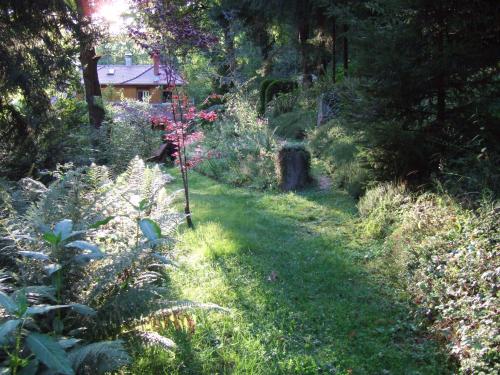 Walking meditation path.
Master Ryokan Read More @ SourcePema Chodron: Smile at Fear - Living From The Heart This posting includes an audio/video/photo media file: Download Now |
| Rare Buddhist manuscript Lotus Sutra released Posted: 05 May 2012 09:00 PM PDT BBC, May 5, 2012New Delhi, India -- A rare Buddhist manuscript, discovered by cattle grazers in 1931, has been released in book form in India.
The Lotus Sutra was discovered in 1931
The document, which dates back to 5th century, is perhaps the only Buddhist manuscript discovered in India. Believed to be one of the most revered Buddhist scriptures, it represents the discourse delivered by Buddha towards the end of his life. The Gilgit Lotus Sutra is kept at the National Archives of India in the capital, Delhi. 'Important find' The book - a facsimile edition which is an exact replica of the manuscripts - will be launched by the National Archives jointly with the Institute of Oriental Philosophy and Soka Gakkai, a Japan-based non-governmental organisation recognised by the UN. "This will help greatly to preserve the rare documents for posterity and make them available for future research," Prof Mushir-ul Hasan, Director General of National Archives of India, said. The manuscripts were discovered in a wooden box in a circular chamber inside a Buddhist stupa by cattle grazers who brought the box to the Wazir of Gilgit. The Wazir of Gilgit sent it to the Maharaja of Kashmir in Srinagar. The document was studied by Hungarian-British archaeologist Sir Aurel Stein who announced the important find to the world. Officials at the National Archives say the ancient manuscripts managed to survive for centuries because they were written on the bark of the bhoj (birch) tree which does not decay and were kept in the freezing sub-zero temperatures of the Gilgit region. The Lotus Sutra is one of the most sacred scriptures of Mahayana Buddhist, which is strongest in Tibet, China, Taiwan, Japan, Korea, and Mongolia. Read More @ Source |
| Buddhism And Meditation: Why Most Buddhists In The World Don't Meditate Posted: 05 May 2012 08:00 PM PDT by Lewis Richmond, The Hiffington Post, May 2, 2012San Francisco, CA (USA) -- It may be a surprise to many Americans, and even to American Buddhists, to hear that the vast majority of the world's Buddhists do not meditate. But it is true. Among the 250 million or so Buddhists alive today, only a tiny fraction have a regular meditation practice; this is true not just for Buddhist laypeople but even for many of the Buddhist monks, nuns, and priests in the various Asian countries where Buddhism is the main religion.
When I first came to meditate in the late 1960s, it was at Sokoji temple, a Soto Zen temple in San Francisco originally founded by Japanese-Americans many decades earlier. The abbot there, Shunryu Suzuki, had come a few years earlier to tend to its Japanese-American congregation. At that time in San Francisco the counterculture was in full swing, and the city was awash in young Americans who had been inspired by the Zen books of D.T. Suzuki, Alan Watts, and Philip Kapleau, as well as by mind-altering drugs. When they showed up at Sokoji to learn to meditate, Suzuki welcomed them.
We meditators did not interact much with the Japanese-Americans. Though we shared the temple space, we attended on different days, so we rarely saw them. A few of the older Japanese-Americans were sympathetic to our interests¸ and Suzuki did his best to explain our presence, but there was still some underlying tension. We meditators did not understand our Japanese-American hosts very well, or they us. Somehow Suzuki, through his sincerity and personality, held it all together. This state of affairs is to some extent still true today. Even though Buddhist meditation has become widespread throughout the West, there is not much real interchange between the myriad ethnic Asian-American Buddhist congregations--Chinese-American, Vietnamese-American, Cambodian-American, Korean-American, and so on--and the meditation and retreat centers that serve a primarily Caucasian following. One of the main differences, of course, is that ethnic Buddhists were born into their faith, while today's Caucasian meditators are almost all adult converts (though as their own children have come to adulthood, that is changing). I wonder if the coming together of these two groups is the next phase of Buddhism's modern revival. Ethnic and non-ethnic Buddhists share a great deal. They are both committed to the enlightened ideals of Buddhist wisdom, to an ethical life based on precepts, to the principles of compassion, kindness, and non-injury, and to the Buddha as an exemplar of a wise, mature human being. Statues of Buddha--which are venerated in every Buddhist temple all over the world--are a kind of visible meditation instruction. We sit just as the Buddha sat. So even though the Japanese-American congregation of Sokoji did not practice formal sitting meditation, they bowed to the same Buddha we did. We were all Buddhists together. These days I regret that I did not make more of an effort to befriend these Japanese-American congregants and learn from them. I think I could have benefited from their experience and outlook. Sitting meditation is based on one simple, universal principle: that sitting still is a source of wisdom. The poet Gary Snyder believes that the origin of sitting still this way can be found in early hunting, in which the hunter had to stand or sit still for long periods, waiting for game to come. There is actually nothing intrinsically Buddhist about sitting still. It is the birthright of every human being. The historical Buddha simply discovered what has always been a timeless truth. These days, monks in Asia, weighed down by centuries of tradition and custom, have in some cases lost touch with this universal aspect of sitting, and no longer have a clear understanding of why to do it. One Zen monk from Japan who was visiting a Zen retreat center in America observed the enthusiasm and numbers of meditators with astonishment. "How do you get them to meditate without beating them?" he asked. In his training temple in Japan, the young monks disliked meditation, and saw it as an unpleasant burden. I believe today's world is re-awakening to the realization that sitting still is a source of wisdom, partly because it is deeply true, and partly, I think, because we so desperately need it. Yes, in one sense most Buddhists don't meditate, but in a more universal sense all people, of whatever faith, are as close to meditation as the nearest cushion or chair. In that sense, everyone can meditate. Follow Lewis Richmond on Twitter: www.twitter.com/lewrichmond Read More @ Source |
| Posted: 05 May 2012 07:00 PM PDT BY KELSEY GEISER , Stanford Report, May 1, 2012
Stanford Religious Studies Professor Carl Bielefeldt says that the meditation practice that's gained traction in the U.S. strays far from ancient Buddhist techniques. Stanford, California (USA) -- For many Americans, "yoga" conjures up mental images of athletic-minded people engaging in a simultaneous "warrior pose" while being told to focus on their breathing.
What many yoga enthusiasts may not realize is that this athletic practice represents only one of the various ways in which aspects of Buddhism have infiltrated the secular American culture. From its start, Buddhism has emphasized the achievement of a state of liberation and enlightenment, which can be achieved through a variety of methods, including meditation. Historically, this mentally challenging practice has been limited to monasteries and not even utilized by the typical Buddhist. Over time, however, the less technical forms of meditation have become popular in the United States – a glimpse of which can be seen in the athletic practice of yoga and its focus on counting one's measured breaths.
Tracing the route to modern Buddhist meditation As the editor of a project to translate the scriptures of the largest school of Zen in Japan, the Soto Zen School, Bielefeldt is shedding light on the works of the 13th century Zen master Dogen. Bielefeldt said he is providing annotation and translation of the master's often-obscure essays in hopes that the English translation will help his work to be more accessible to the international community. Buddhist meditation has taken a long journey to reach U.S. shores. While it technically began in China in the seventh century, it was not popular in countries such as Japan and Korea until approximately 1200. When Japan opened itself to the West in the 19th century, Buddhism changed forever. As Western ideas of religion and the academic field of religious studies began to flood into the country, many citizens began to view their spiritual practice of Buddhism as a form of religion for the first time. Not only did Western influence come into the country, but Japanese traditions of Zen flowed out as well. "Zen became popular in the West, but then there was a certain kind of feedback system where people in Japan became more interested in Zen, saying 'Oh, other people outside of Japan find this interesting, maybe there is something more to it,' " Bielefeldt said. Despite this feedback system, the movement of meditation from the monasteries to ordinary communities in Japan and other Asian nations did not rival the movement in the United States. As Buddhism moved to the western hemisphere, meditation began to spread into the broader cultures, even outside of the religious realm. Today, Bielefeldt notes, meditation is used in health care as a way of coping with pain and in the sports industry as a way to focus the mind. "We [Americans] don't really have much example, certainly to this degree, of a religion escaping from its religious tradition and background and community into the broader culture," said Bielefeldt. "We are looking at a religion that is going to have broader diffuse influence on American culture than any other major religion." Bringing meditation theory into the classroom Recently, Bielefeldt brought his broader interest in meditation into the classroom. His winter-quarter class on Buddhist Yoga was created to give students a basic understanding of meditation's role within Buddhism and societies across the globe. Bielefeldt connected with students through an emphasis on meditation's journey from Japanese monasteries to San Francisco apartments. "Meditation appeals to what is more interesting, typically, about Buddhism," said Bielefeldt. "It is a religion in which we can do something, do a practice, a kind of utilitarian or therapeutic practice." The class focused on meditation as a form of Buddhist soteriology or, in other words, as a theory of salvation or "what people in the religion want or expect to get, hope to get, and how they get it." In class, Bielefeldt focused on the meditation path taken by some Buddhists to achieve this salvation. Buddhism, unlike other religions, is not a way of life, but rather a means to get from one state to another. "Buddhism is often said to be a raft that takes you from one shore to the other shore," said Bielefeldt. "Then you don't carry the raft with you afterwards." Buddhists generally strive to achieve the three elements of the spiritual discipline before they can reach their desired end state of awakening: ethics, mental (including meditation) and wisdom. "Meditation is a kind of door between the elements," said Bielefeldt. "In one sense it's a kind of behavior, so it has to do with ethic. In another sense it involves certain states of understanding, so it is connected with wisdom." While some Buddhists approach meditation through the traditional practice of visualization, "It is really complex and requires a lot of work," said Bielefeldt. "It is not a thing that you can just sit down and do on a Saturday." The technicality of this meditation has, for the most part, been limited to Buddhists in monasteries rather than ordinary practicing Buddhists. It is only since the 20th century that there have been concerted efforts to bring meditation practices out of the monasteries. Through this movement, the more popular forms of meditation have been the less technical ones, the "mindfulness practices." These mindfulness practices, however, have taken a much stronger hold in ordinary communities in the United States than in many Asian countries. Read More @ SourceMeditation talk on Being Brave Transforming our World - Shambhala Acharya Adam Lobel This posting includes an audio/video/photo media file: Download Now |
| Thai Buddhist temple to undergo facelift Posted: 05 May 2012 06:00 PM PDT By Jennani Durai, The Straits Times, May 5, 2012
$ 5.5m project will add space to Jalan Bukit Merah shrine Singapore -- The oldest Thai Buddhist temple here will get a drastic facelift by next year.
Temple officials, timing this announcement for Vesak Day today, unveiled plans for a futuristic- looking new building on the same site in Jalan Bukit Merah. It will occupy 1,500 sq m, more than twice its current 600 sq m of space, which means the temple will finally be able to have the dedicated classrooms its minders say are sorely needed for lessons on the faith. Read More @ Source |
| Karmapa Lama attends workshop on global peace in Dharamsala Posted: 05 May 2012 05:00 PM PDT ANI , 3 May 2012Dharamsala, India -- The 17th Karmapa, Ogyen Trinley Dorje attended a workshop on global peace and Meditation here earlier this week.
Addressing the workshop, Karmapa Lama praised the friendly relations between India and Tibet and expressed gratitude to the government for their support. "India and Tibet have historical relations and it's our responsibility to tell about it to our younger generation and we hope that the friendly relation continues for millions of years," said Karmapa, Ogyen Trinley Dorje. The 17th Karmapa, Ogyen Trinley Dorje, is the third most important Tibetan spiritual leader. The Karmapa Lama is regarded as the third most important leader in the Tibetan hierarchy after the Dalai Lama and the Panchen Lama. China has ruled Tibet with an iron fist since Communist troops marched into Tibet in 1950. It says its rule has bought much needed development to a poor and backward region.
Tibetans fear that China will use the thorny issue of the Dalai Lama's religious succession to split the movement, with one new Lama named by exiles and one by China after his death. Meanwhile, leader of India's radical Hindu-right-wing organisation, the Rashtriya Swayamsewak Sangh (RSS), Indresh also attended the event and discussed about global peace. Tibetan Interior Minister In-Exile Gyari Dolma said that development can take place in the area only if peace prevailed. "There is a meeting organized by the 'Himalayan Family'. 'Himalayan family' represents the entire Himalayan belt, the transit Himalayan belt and the topic today was on the Buddhist religion and global peace and also the second topic for discussion today at this meeting is the dangers that the Himalayas face today," said Gyari Dolma. The 'Himalayan Family' is a non-government organization, which helps the people living in the Himalayan belt to overcome the challenges of poverty, unemployment and communalism. (ANI) Read More @ Source |
| Famed Buddhist nun in antinuclear hunger strike Posted: 05 May 2012 04:00 PM PDT The Japan Times, May 3, 2012Kyodo, Japan -- Novelist and Buddhist nun Jakucho Setouchi joined a hunger strike Wednesday in front of the industry ministry in Tokyo in protest the government's moves to restart idled reactors at the Oi nuclear power plant in Fukui Prefecture.
Setouchi, 89, together with writers Hisae Sawachi, 81, and Satoshi Kamata, 73, plans to stage her hunger strike until sunset. The antinuclear civic group began the hunger strike on April 17 in front of the Ministry of Economy, Trade and Industry, which oversees nuclear power plant operators, in Tokyo's Kasumigaseki district, home to a number of government buildings. The group plans to continue its hunger strike until Saturday, when the country's last operating commercial nuclear reactor, unit 3 of Hokkaido Electric Power Co.'s Tomari plant, is due to go offline for routine checks. Pinning a band with the message "no to reactivation" to her nun's habit, Setouchi said Japan is in as bad a state as she has known in her almost 90 years of life. "I can't hand over the current Japan to the younger generation," she said. In the wake of the disaster-triggered nuclear crisis in Fukushima Prefecture, Setouchi described the government's moves to restart two idled reactors at Kansai Electric Power Co.'s Oi plant as "scary." "I think (the government) is acting strangely," she said. Read More @ Source般若心経(清新版)Prajna Paramita Heart Sutra (Relaxing Version) This posting includes an audio/video/photo media file: Download Now |
| A Monk's Earthly Mission: Easing North Koreans' Pain Posted: 05 May 2012 03:00 PM PDT By CHOE SANG-HUN, New York Times, April 27, 2012
SEOUL, South Korea -- IN August 1996, the Venerable Pomnyun, a Buddhist monk from South Korea, was cruising down the Yalu River between China and North Korea when he saw a boy squatting alone at the North Korean edge of the water. The boy was in rags, his gaunt face covered in dirt.
"Never before had I realized the meaning of a border so painfully until that day," said Pomnyun, 59. "Never before had I felt so acutely that Korea is a divided nation." The encounter led him to establish one of the first relief campaigns for North Korean refugees and to take on an unlikely role for a Buddhist monk. Today, rather than leading a secluded life of quiet contemplation, he is a well-known commentator on North Korea, his online newsletter an important source of information smuggled out of the isolated country. Before his Yalu trip, Pomnyun had refused to believe his Chinese acquaintances' stories about countless North Koreans dying of hunger as the country's food rationing system collapsed in the midst of a famine. But once he was confronted with the evidence, the monk, who was already running a charity in India, sent volunteers to northeastern China, providing food and shelter for the thousands of North Korean refugees who had begun straggling over the river border. When his organization, Good Friends, released photographs of the bodies of North Koreans who had drowned in the river, too exhausted to complete the last leg of their desperate journey for food, it provided some of the first documentation of what was later recognized as one of the most horrific famines of the late 20th century. As many as three million people out of a population of 22 million died of hunger or hunger-related diseases. WHAT shook Pomnyun was not only the tales that refugees told of families trying to live on pine tree bark and wild roots, but also the outside world's ignorance of their plight. "World leaders and the media talked obsessively about Kim Jong-il and his nuclear weapons and missiles," Pomnyun said. "But what about the North Korean people?" Pomnyun's group began to chronicle the disaster, interviewing more than 5,000 refugees as they arrived in China and publishing a series of reports and books on their struggles. When Good Friends began publishing its newsletter in 2004, it quickly became a must-read among South Korean policy makers and journalists. The first of its kind, the newsletter provided timely accounts of life in North Korea from anonymous informers inside the country, some of whom had returned home after being aided by the charity. They communicated via smuggled cellphones and other means that Pomnyun refused to disclose. When the newsletter, North Korea Today, also went online, it became a prototype for other Web sites. Together, the sites have helped breach what had been a near-total information blackout on North Korea for decades. They monitor the price of food and carry running, though sometimes conflicting, updates on floods and epidemics. Pomnyun leads his own temple in a provincial town, as well as study programs in meditation and Buddhist scripture across the country. Born to a rural farming family, Pomnyun grew up with older brothers who were religiously and politically active; one was sentenced to death under the military dictatorship of the time for antigovernment activity, but was later released. The younger Pomnyun at first hoped to become a physicist or an astronomer. But when he was in high school, a chance meeting with a revered monk named Domun persuaded him to become an activist, starting campaigns for environmental protection, religious reform, aid for the hungry and unification of the two Koreas. He was arrested and tortured by government agents cracking down on dissidents during the military rule. Today, Pomnyun pursues his mission very much amid the secular world. His office in Seoul is in a back alley crammed with restaurants, bars and "love hotels," where people meet for trysts. Government officials call to compare notes on North Korea. He travels to the United States to give lectures attended by academics and government analysts. His writings and appearances - he gives an average of 12 lectures a week on a range of topics, including how to be a good mother - have made him among the country's best-known monks. "Pomnyun quotes" are widely shared online. A recent one went: "Even if the North Koreans are said to be our enemy, they are fellow Koreans. While we are turning our surplus rice into animal feed, North Korean children are dying of hunger. What would our ancestors say of this?" His social activism has even drawn him into the tumult of South Korean politics, especially after lectures that he organized for young audiences on topics like how to fight for social justice provided a platform for Ahn Cheol-soo, a software developer and a vocal critic of the governing New Frontier Party. Mr. Ahn is now cited in opinion polls as a leading contender in the presidential election in December, should he choose to run. Allinkorea.net, a rightist news outlet, has made Pomnyun a favorite target, calling him a "political demagogue wearing the mask of religion." POMNYUN'S tireless appeals for more aid for North Koreans have not always been popular in the South, where sentiment toward the North vacillates between compassion and fear. In 2006 and 2009, his group's reports on destructive floods and an outbreak of swine flu in North Korea prompted the South Korean government to set aside politics and send aid. But his appeals have gone largely unheeded under President Lee Myung-bak's conservative administration, which has accused Pomnyun of exaggerating the latest food crisis. Pomnyun has countered that the government is playing politics with people's welfare. In 2008, he went on a 70-day hunger strike to highlight North Koreans' plight. Good Friends' statistical methods in its early studies led even some relief experts to accuse the group of exaggerating the famine, either unwittingly or to promote its case for aid. But Rajiv Narayan, a researcher on North Korea at Amnesty International, said the early work, even if flawed, "helped us understand what was going on in North Korea." He added of Pomnyun, "People in our circles listen to him." Pomnyun says he takes the criticism in stride. "Progressives criticize me for drawing attention to human rights violations in the North, and conservatives attack me for calling for aid for the North," Pomnyun said, adding that he had also, depending on the critic, been accused of working for the C.I.A. or the North Korean government. "My aim is neither to support nor to oppose North Korea. I am just drawing attention to the humanitarian crisis." For that reason, Pomnyun is deeply skeptical not only of his own country's policies toward North Korea, but also of the United States' focus on the threat the country poses. "The problem," Pomnyun said, "is the more you squeeze the North Koreans, the more desperate they become to develop nuclear weapons. The Americans keep asking, 'Why do the North Koreans make nuclear weapons while their people are starving?' That may be a good way of criticizing North Korea, but it's not a good way of influencing a paranoid regime whose overriding priority is self-preservation." Read More @ Source |
| Posted: 05 May 2012 02:00 PM PDT By Gyalsten K Dorji, Kuensel Online, May 3, 2012Timphu, Bhutan -- An international conference on Buddhism will be held in Bumthang, this month. The conference, organised by the home ministry and the centre for Bhutan studies (CBS), is themed "Buddhism without Borders", and will see "eminent" Buddhist practitioners, scholars, and academics of the international and local community, attending the event. "The conference will provide an opportunity for creative discussions and shared explorations of these subjects and their application in today's world amongst a cross section of Buddhist nations and cultural set-ups which it is hoped, will pave the way for key future collaborations," it adds. The conference will see its invitees discussing a range of topics ranging from traditional Buddhist motifs to emerging developments in the global Buddhist scenario, for instance, one theme is on "cyber buddhism and the new age Buddhist expression". The home ministry and CBS are organising the conference in a continuing effort to promote research, scholarship, dialogue, and a greater understanding of the Buddha dharma, and as a measure to bolster the critical position of Bhutan in the Buddhist world, says the press release. "This conference is an attempt at broadening the understanding of the basic tenets of Buddhism in collaboration with renowned academics from around the world," states the press release, adding, "It is hoped that the conference will pave the way in initiating collaboration in the academic understanding of the subject, which will ultimately lead to the promotion of goodwill and cooperation among leading thinkers in promoting widespread understanding and subscription to the values that make for a better world." The conference will be held May 21-23. Looking for Ancient Tibet (English Sub, German Audio) This posting includes an audio/video/photo media file: Download Now |
| Afghan museum highlights country’s Buddhist heritage Posted: 05 May 2012 01:00 PM PDT By Lawrence Bartlett, The Daily Star, May 5, 2012KABUL, Afghanistan -- Afghanistan achieved global notoriety when the Taliban blew up the ancient Bamiyan Buddhas 11 years ago. This week opened an exhibition that highlights the country's rich Buddhist heritage.
As if to underline the departure from Taliban-era aesthetics, the exhibition is being hosted at the National Museum, rebuilt with international aid after being destroyed by civil war. Overlooked by the ruins of the neoclassical Darulaman Palace, the museum interior is a sanctuary of quiet arches and marble floors in a violent land. In the entrance hall is a replica of the Great Buddha of Bamiyan, one of two giant standing statues carved into the cliffs of Afghanistan's central highlands in the sixth century.
One statue shows a lean-torsoed Buddha that, according to museum curator Surkh Kotal, reflects Greek artistic influences introduced in the wake of Alexander the Great's invasion of Afghanistan. Others show damage inflicted during Taliban rule, when many of the museum's artifacts were destroyed. Among the items spared are relief carvings depicting the Buddha's life and other artifacts from former Buddhist monasteries in Afghanistan, mainly south of the Hindu Kush mountains. One of those behind the protection of the treasures is museum director Omarakhan Massoudi, who joined the museum 34 years ago. "I'm happy we preserved some masterpieces through a difficult time in our country," said Massoudi, recounting how a decision was made to move major works to secret locations in 1989 as Soviet forces withdrew and civil war loomed. During that war, he added, some 70 percent of the artifacts were looted and smuggled into neighboring countries to find their way onto the black market. The museum, along with the palace on the hill, was largely destroyed as rival warlords unleashed artillery and rocket fire on the capital in a brutal struggle for power. Then came the Taliban. Toward the end of their rule they destroyed more than 2,000 artifacts, Massoudi said, and blew up the Bamiyan Buddhas as "idols" in March 2001. "We have repaired more than 300 statues," said Massoudi. "Some are on display and we will continue this activity in the future." The destruction of the Bamiyan Buddhas, he continued, was "a big tragedy because they were a part of our history, a part of our culture." Lying on the famed Silk Road trading route connecting east and west, Afghanistan absorbed Buddhist from India and the religion flourished for hundreds of years before the arrival of Islam in the eighth century. Buddhism has since virtually disappeared from a country where more than 99 percent of the population proclaim themselves Muslim. The museum is dedicated to keeping the nation's history alive. "We have to be proud about this very rich heritage of Afghanistan," said Massoudi, "and we need to transfer it to the next generations." In a country still at war, it is still unsafe for the museum to display some of its most important possessions. The priceless 2,000 year-old Bactrian Gold collection of more than 20,000 gold ornaments, hidden by museum staff during the civil war, has been touring the world since 2006. Closer to home, the ruined grandeur of the Darulaman Palace – clearly visible from the museum – stands as an enormous exhibit reflecting a less than glorious period in the nation's history. Read More @ Source |
| 2600th Anniversary of the Buddha's Enlightenment and Sri Lankan Contribution to Meditation Posted: 05 May 2012 12:00 PM PDT By Ananda W. P. Guruge, The Buddhist Channel, May 5, 2012
The speech delivered at the Washington D.C. Buddhist Vihara on March 23, 2012
1. Would we have met today to celebrate the 2600th Anniversary of the Buddha's Enlightenment, if not for Sri Lanka? 2. Would the world have known and remembered the historic Buddha and his role as the founder of this all-important spiritual and cultural heritage and venerated him as the foremost teacher and social reformer of his time, if not for Sri Lanka? 3. Would the Pali language and the Buddha's original and the authentic teachings to humanity as recorded in the PaliTripitaka and the Pali commentaries have survived to serve us now as they do, if not for Sri Lanka? I am proud to stand before you as a Buddhist, born and bred in Sri Lanka, and tell you as an objective professional historian without any trace of chauvinism that the answer to each of these three questions is a resounding NO. First, about the date. If not for the traditional Buddhist chronology preserved in Sri Lanka and accepted by the Southern Buddhist countries of South and Southeastern Asia, we will have to wait for at least sixty more years to celebrate this day. According to what is generally calculated by scholars, the 2600th anniversary of the Buddha's Enlightenment will fall somewhere around 2071-72. Far more important is the question relating to the memory of the historical Buddha. If Emperor Asoka had not sent his son and daughter to introduce Meditation to Sri Lanka and if this Island nation had not conserved his teachings in pristine purity, renewing when needed with missions from Myanmar and Thailand to revive higher ordination of monks, the historical Buddha along with his teachings would have receded to oblivion if not to a econdary position as it has happened in other Buddhist traditions. He would have been relegated to the background and the prominence given to the cosmic Amitabha Buddha,DhyaniBuddhas and the Buddhas of the ten thousand Buddha-worlds and numerous Bodhisattvas and Taras. This happened not only in the countries to which Meditation was introduced later but in the very land of its origin, India, where the Mahayana and the Vajrayana traditions developed at the expense of early Meditation. The preservation of the unadulterated memory of the historical Buddha, as an awakened human being and not a reincarnation of a deity, and his original teachings directly to fellow humans is an immense service rendered not only to the Buddhists but also to the humanity. Otherwise the world today would not have come to admire and appreciate the Buddha as a paragon of virtue and Meditation as the beacon of wisdom and ethical perfection for which parallels are hard to find. From the third century before Christ -- that is from the day Meditation was introduced to the Island – to about the first century after Christ, Sri Lanka carried on a massive literary enterprise of preparing comprehensive commentaries in the old Sinhala language. Known as the Sihalatthakatha or Helatuva, these commentaries were an essential aid to the study of Meditation not only in Sri Lanka but also the mainland. Translated into the same language as the PaliTripitaka in the fifth century by Buddhaghosa from Buddha Gaya and Dhammapala and Buddhadatta from Tamil Nadu, these commentaries remain the indispensable tools for the study and understanding of the complex teachings of the Buddha. In the first century before Christ, the Sangha of Sri Lanka met at Aluvihara in Matale and wrote for the first time the whole of the Tripitaka and the commentaries in books so as to save them from both natural and man-made disasters. Of all the compilations of the Buddha's teachings in different Indian languages, only the Pali Canon has come down to us in a language closest to what the Buddha used. The logical flow and the internal consistency of its contents and the clear contrast in diction which reveal later interpolations testify to its authenticity. It can also be verified by comparison with the Agama Sutras of the Chinese Tripitaka, which represent the translation of the Sarvastivadin Canon in Sanskrit. Without the PaliTripitaka which exists today in complete translations into several modern world languages, the knowledge of Meditation would have been lop-sided and even inaccurate and misleading. I even wonder whether Meditation would have elicited the admiration that it now enjoys especially as intellectuals seek to uncover the original teachings of the Buddha. It was therefore not surprising that when Portuguese persecuted Muslims, the Buddhist kings of Kandy settled them in safety and security in the Eastern Province and when the Portuguese in their turn were subject to dire persecution by the Dutch Reformed Church, the same kings built churches for them in places like Wahakotte and enabled missionaries from Goa like Father Joseph Vaz to minister to them. Around the beginning of the Christian era, a Sri Lankan in some authority appears to have been in the monastery of Ajantha to see that the largest and most prominent mural in Cave XVII represented the colonization of the Island by Sinhalas. That again is not altogether unlikely when we find that around the same time the chief disciple of the great Buddhist philosopher Nagarjuna was Aryadeva, a prince from Sri Lanka. This Aryadeva, who authored Catussataka, succeeded Nagarjuna as the Abbot of the Nalanda University. Inscriptional evidence from Nagarjunakonda, which credits Sri Lankan monks of the Sihalavihara there with missionary successes in Kashmir, Gandhara, China and various parts of India, testifies to Sri Lankan contacts with the Buddhist centres of Andhra Pradesh and that would also explain how Buddhaghosa had access to the Andhatthakatha or Andhra commentaries in Mahavihara at Anuradhapura. It was then too that, endangered by warfare, the king of Kalinga sent the Sacred Tooth Relic to Sri Lanka for safety. King Silakalamegha negotiated with the second Gupta Emperor Samudragupta to build a Pilgrims' Rest in Gaya for Sri Lankan pilgrims visiting the Sacred Bodhi tree. Inscriptions reveal its continuous use by Sri Lankan monks almost up to the disappearance of Meditation from India. According to Pichuni-chuang, within two decades of this, a team of Sri Lankan bhikkhunis led by Devasara braved the stormy seas and proceeded in a ship, captained by one Nandi, to establish the Bhikkhunisasana in China. It is significant that this historical antecedent facilitated the resuscitation of the Bhikkhunisasana in Sri Lanka with the monks from Asgiriya and nuns from FoGuang Shan conducting the dual ordinations in 1998 at Buddha Gaya. Yi-Ching records the visits of several Chinese monks on pilgrimage to Sri Lanka and even mentions how one of them was caught attempting to steal the Sacred Tooth Relic. It is also interesting to note that Gunavarman, who fled to Sri Lanka to escape being made the king of Kashmir, became a monk and in due course went via Sri Vijaya to China and became an important authority of the Vinaya. Equally important is that the Chinese Vinaya Commentary Shan-jian-lu-piposha appears to be a direct translation of a Sinhala commentary older than its translation into Pali by Buddhaghosa asSamantapasadika. It is around the same time that a treatise on the Mind-only doctrine of the Yogacara School had a new introduction added to it in order to name it Lankavatarasutra. Chinese history over a millennium records as many as twenty-four missions of emissaries from Sri Lanka to the Imperial Court and some of them were connected with Meditation. One of them was that of Amoghavajra and his teacher Vajrabodhi.Amoghavajra played a major role in spreading Tantric Meditation in East Asia and is considered a patriarch of the Shingon Sect of Japan. That Abhayagiri Monastery was predominantly connected with the outreach of Sri Lankan Meditation to foreign lands is established by the documented discovery of its branch at the Shailendra capital Ratuboka in Indonesia. Monks from Sri Lanka at Nakorn Si Thammarat in the Kingdom of Ligor played a key role in the spread of early Meditation in both Myanmar and Thailand. It was how it was possible for Vijayabahu I to obtain monks from Myanmar to restore higher ordination after the defeat of the Cholas in the eleventh century. Historically the most impactful event in Sri Lanka which changed the face of Meditation in the region was the unification of the three Monasteries at the behest of Parakramabahu the Great in the twelfth century. Called by scholars the Sinhala Reform, a new form of Meditation evolved as an amalgam of all three traditions. Its intellectual base was the Pali Canon and its commentaries, resulting in the ultimate disappearance of Mahayanasutras in Sanskrit. But the inclusion of the ritualistic aspects of the Mahayana and Vajrayana traditions appealed to the people. Not only Sri Lanka but also the neighbouring countries found the new form of Meditation more acceptable as a practical religion to suit changing conditions. Thus before long monks like Chapata of Myanmar, whose team included a prince from Cambodia, came to take the new higher ordination to their countries. Still called somewhat erroneously as Theravada Tradition, it was welcomed in Myanmar, Thailand, Cambodia, Laos, Yunnan Province of China and the Mekong Delta of Vietnam. Along with it, the Pali language and the rich Pali literature of Sri Lanka went to these countries and for several centuries Pali was the lingua franca of communications among them. An event of lasting consequence for not only Myanmar but also its neighbours was the mission to Sri Lanka of the Myanmar King Dhammazedi, formerly an ordained bhikkhu of the Sinhala Sangha. This mission consisting of a large number or bhikkhus was sent in 1476 for them to be re-ordained so that a purification of the Myanmar Sangha could be implemented. An inscription recording the re-ordination at what was called the Kalyanasima indicates that the mission brought with it an entire library of manuscripts to be transliterated and diffused in Myanmar and its neighbors. A Pali inscription of Cambodia records that King JayavarmanParamesvara patronized Sinhala Meditation around 1307 and his son-in-law introduced it to Laos. By the mid-fourteenth century, Sri Lankan Meditation was firmly established in Southeast Asia and Sri Lanka was looked upon as the religious metropolis. British missionaries and Civil Servants were the first to bring the Buddhist heritage of Sri Lanka to the attention of the modern world. Within nine years of the Kandyan Convention, Benjamin Clough published his A Compendious Pali Grammar in London. When the pioneering epigraphist James Princep and scholars in India were in a quandary over identifying Devanapiya in Asokan inscriptions, George Turnour, the Government Agent of Hambantota, discovered the Sri Lankan chronicle Mahavamsa in the Mulgirigala temple and enlightened them. Not only did he publish it with an English translation in 1836 but appended to it a comprehensive survey of the Pali literature. Buddhist scriptures in Pali came to be studied by Christian missionaries and their early translations like that of the Sigalovadasutta, RatthapalasuttaandDhammacakkappavattanasutta by D. J. Gogerley from 1846 raised the prestige of Meditation among the intellectuals. It was no longer a pagan religion confused with devil-dancing and superstition. The rule that officers sent from England to administer the colony should acquire an in-depth knowledge of the language and culture of the Island brought them into close contact enterprising Buddhist monks like YatramulleDhammarama, DodanduwePiyaratanatissa, Hikkaduwe Sri Sumangala, Weligama Sri Sumangala, Waskaduwe Sri Subhuti and AlutgamaSeelakkhandha. Many of these officers became promoters of Pali and Buddhist scholarship not only in Sri Lanka but also in the world as a whole. The most remarkable of them are Robert C. Childers who published the first ever Pali English dictionary in 1875 in London and T. W. Rhys Davids, who excelled as the father of Buddhist Studies as a university discipline in not only England but in the West as a whole. The founding of the Pali Text Society of London in 1881 remains undoubtedly his most durable contribution. In their wake came the contributions of ViggoFausboll of Denmark, RheinholdRost and Lord Chalmers of Britain, Herman Oldenberg and Wilhelm Geiger of Germany, Edmund Hardy of Switzerland and J. Minayeff of Russia. It is interesting to note that the scholar-monks who came into close contact with the British Civil Servants were the dominant activists of the Buddhist Revival Movement. On the one hand, it began with the public debates between them and the Christian missionaries. The Debate of Panadura of 1873 brought Colonel Henry Steel Olcott to Sri Lanka. His two protégés AnagarikaDharmapala and Sir Don Baron Jayatilaka dominated the scene well into the twentieth century. On the other hand, the Movement concentrated on the development of Buddhist education. The result as far as the promotion of Meditation in the world was manifold. Anagarika Dharmapala reintroduced Meditation to India, created the very first modern international Buddhist forum in the form of the Maha Bodhi Society, succeeded in getting the Indian Buddhist shrines restituted to Buddhists, presented Meditation to the first Parliament of World's Religions in 1893 in Chicago and established the London Buddhist Vihara in 1925. Associated with this temple are two notable monks, namely Venerable Narada whose most significant contribution is the introduction Sri Lankan Meditation to Nepal and Vietnam and Venerable Dr. HammalawaSaddhatissa who administered pancasila to BabasahebBhimraoAmbedkar and paved the way of the millions of new Buddhist converts in India. Last but not the least, a lasting service to Meditation was rendered by Professor GunapalaMalalasekera who in 1950 founded the World Fellowship of Buddhists which continues to be active after sixty years as the most representative international Buddhist forum in the world. It is with great pleasure that I announce the completion of the monumental Encyclopaedia of Meditation which he started with me in 1954 as a project to mark the 2500 Buddha Jayanti. Let us express our thanks to many generations of the Sangha and other scholars, missionary monks and nuns and the pious adherents for having safeguarded this precious heritage for the whole of the humanity. We shall never be able to ever fulfill our national debt to the Sangha, without whom Sri Lanka would not have earned the glory of being the lasting home of Meditation for over twenty-three centuries. Nor would we have the credit for not only having preserved but also shared with the world the noble message of the Buddha. Read More @ SourceFirst Video This posting includes an audio/video/photo media file: Download Now |
| Posted: 05 May 2012 11:00 AM PDT By Poonam Srivastava, Deccan Chronicle, May 4, 2012New Delhi, India -- On this Buddha Purnima, which falls on May 6, I would like to recommend that we revisit the three jewels of Buddhism to mark the event. Also known as the "three refuges", they are often chanted at Buddhist festivals. They are known as tri-ratna in Sanskrit and ratana-traya in Pali translations. It says: Buddham sharanam gacchami
The first jewel talks of taking refuge or protection in the Buddha. Here the Buddha is not only representative of the historical figure of the holy Buddha who was born and attained nirvana on Buddha Purnima. But Buddha here also refers to a person who has become spiritually awakened, like Buddha or other monks who attained inner awakening about the supreme knowledge that helped them transcend worldly sorrows to live an enlightened life. We are encouraged to follow these role models, draw lessons from their stories and try to live by their examples by lighting our inner awareness.
The third jewel is about taking refuge in the sangha or the company of fellow seekers as well as teachers, monks and nuns. This is extremely empowering as anyone who has been the part of a group would vouch for the infectious effect of strong group energy. When you are feeling low, it is a great antidote to join a group of practitioners in exercises like meditation or chanting as this helps in building up our inner strength. Sangha also offers great bonding opportunities where you learn of inspiring experiences from other members, which motivate us to carry on with our journey of learning. It also makes one feel secure and provides a comfort zone amid challenging worldly insecurities of daily strife. (Buddha Purnima "Evening of Mindfulness" will be held on May 6, 2012 from 5.45 pm to 10 pm at Sanskriti Kendra, Anandgram, Aya Nagar, New Delhi.) Poonam Srivastava's book, T-Junction Crossing Over for Change, has been published recently. She can be contacted at m4moment@gmail.com Read More @ Source |
| Buddhist celebration set at Hudson Valley Posted: 05 May 2012 10:00 AM PDT Plough Keepsie Journal, Apr. 29, 2012
Meditation, music, lunch set Saturday Hudson Valley, USA -- There will be a celebration of Vesak, Buddhism's holiest day, on Saturday 5 from 9 a.m. to 5 p.m. at Tsechen Kunchab Ling, Temple of All-Encompassing Great Compassion, 12 Edmunds Lane. The event is free.
Vesak commemorates the Buddha's birth, enlightenment and passing more than 2,500 years ago in India. Since 1999, it has been recognized as a United Nations Day. Buddhist temples have come together for annual Vesak celebrations in major metropolitan areas in the United States such as New York City, Washington and Los Angeles. This will be the first time that Buddhists in the Hudson Valley have hosted a joint celebration to meditate together on their holiest day.
People are welcome to drop in throughout the day. "In addition to the spiritual dimension, the program offers a unique and free opportunity to sample the art, music, dance, food and living culture of four different Asian countries, all in a single day right here in the Hudson Valley," said the Rev. Chodrung-ma Kunga Chodron, a Buddhist nun at Tsechen Kunchab Ling who helped organize the event. The program will begin with a colorful procession of Buddhists from many countries doing walking meditation around the new temple building. Inside, monks will perform chants in honor of the Buddha in their native languages. Lunch will be a buffet of vegetarian food from all over Asia, with each participating temple sharing its ethnic cuisine. The afternoon program will include meditation and a talk by Buddhist scholar Venerable Bhikku Bodhi . It will also include a sacred Korean monastic dance expressing the search for truth, and videos of Vesak celebrations in other parts of the world. "People of all faith traditions, and those of no particular tradition, are welcome to join the celebration," said the Venerable Gikwang Sunim, abbot of the Korean Temple, Won Kak Sa. "Everyone agrees about the need for more happiness and compassion in the world." If you go What: Vesak celebration commemorating the Buddha's life, including walking meditation, chanting, lunch, talk, monastic dance and videos. |
| You are subscribed to email updates from BuddhaRocks ☸ Buddhist To stop receiving these emails, you may unsubscribe now. | Email delivery powered by Google |
| Google Inc., 20 West Kinzie, Chicago IL USA 60610 | |

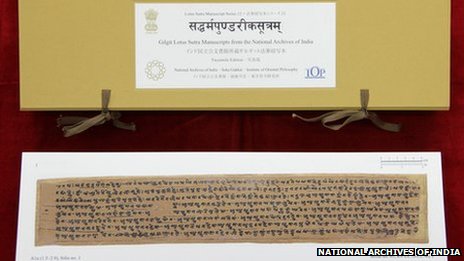
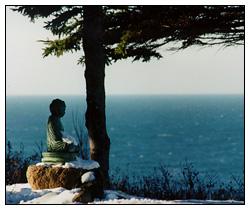 Were things different in the past? Yes, there were times and places where millions of monks and nuns lived and practiced in monasteries where meditation was the norm, but the West's assumption that Buddhism and meditation are one and the same is a selective understanding. There is much more to Buddhism than meditation. Meditation is only one branch of the eight-fold path taught by the Buddha--a path which includes ethical teachings, intellectual study, and transformation of personality and character through wholesome attitudes and deeds.
Were things different in the past? Yes, there were times and places where millions of monks and nuns lived and practiced in monasteries where meditation was the norm, but the West's assumption that Buddhism and meditation are one and the same is a selective understanding. There is much more to Buddhism than meditation. Meditation is only one branch of the eight-fold path taught by the Buddha--a path which includes ethical teachings, intellectual study, and transformation of personality and character through wholesome attitudes and deeds.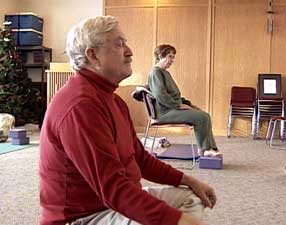 << Religious Studies Professor Carl Bielefeldt has dedicated his academic career to the study of 13th century Japanese Zen, a tradition of Buddhism that emphasizes the practice of meditation. (Photo: everydaybalance/Creative Commons)
<< Religious Studies Professor Carl Bielefeldt has dedicated his academic career to the study of 13th century Japanese Zen, a tradition of Buddhism that emphasizes the practice of meditation. (Photo: everydaybalance/Creative Commons) Only the main shrine of the 89-year-old Wat Ananda Metyarama temple will be preserved in the renovation; everything else will be built anew.
Only the main shrine of the 89-year-old Wat Ananda Metyarama temple will be preserved in the renovation; everything else will be built anew.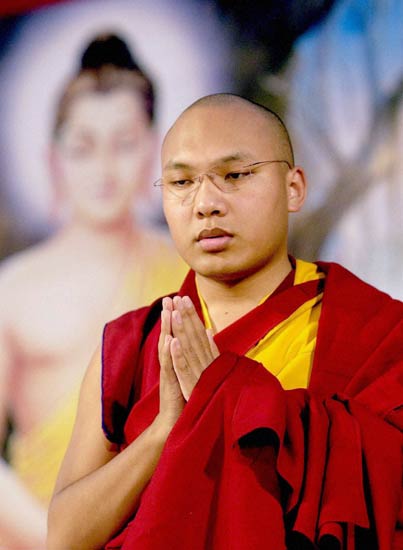 People from different parts of the transit Himalayan belt participated in the event that was organized by a non-government organization.
People from different parts of the transit Himalayan belt participated in the event that was organized by a non-government organization.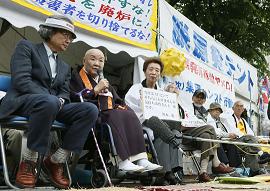 << Starving 'em out: Nuclear foes (from left) writer Satoshi Kamata, novelist and Buddhist nun Jakucho Setouchi and writer Hisae Sawachi join a hunger strike Wednesday in front of the industry ministry in Tokyo. KYODO
<< Starving 'em out: Nuclear foes (from left) writer Satoshi Kamata, novelist and Buddhist nun Jakucho Setouchi and writer Hisae Sawachi join a hunger strike Wednesday in front of the industry ministry in Tokyo. KYODO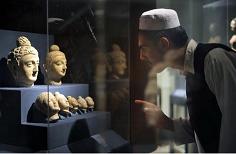 << An Afghan student at the National Museum of Afghanistan in Kabul on April 30. (AFP PHOTO / Bay ISMOYO)
<< An Afghan student at the National Museum of Afghanistan in Kabul on April 30. (AFP PHOTO / Bay ISMOYO)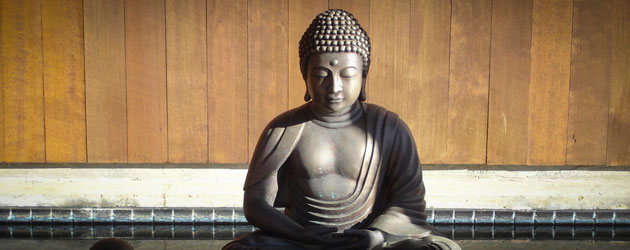
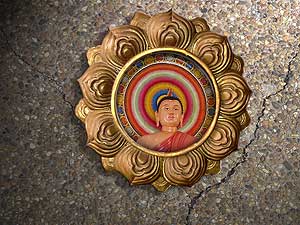 The chants are known as the refuges as all three lines exhort the seeker to take sharan (refuge or protection). Sharan is a key word in spirituality, which is suggestive of faith and surrender. It promises seekers that when we offer ourselves as students on the path of learning we are protected and guidance follows, which helps in our evolution. It is also a non-ego state of our humble life.
The chants are known as the refuges as all three lines exhort the seeker to take sharan (refuge or protection). Sharan is a key word in spirituality, which is suggestive of faith and surrender. It promises seekers that when we offer ourselves as students on the path of learning we are protected and guidance follows, which helps in our evolution. It is also a non-ego state of our humble life.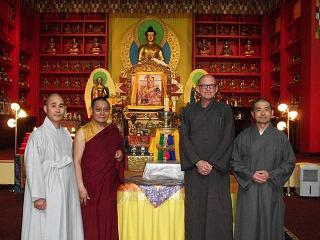 << Abbots of four Buddhist temples gather to plan celebration of the Buddha's life. From left are the Venerable Gikwang Sunim from Wonkaksa, the venerable Khenpo Kalsang Gyaltsen from Tsechen Kunchab Ling, Brother Phap Vu of Blue Cliff Monastery and Venerable Xin-Xing from Dharma Seal Monastery. / Courtesy photo / Written by Journal staff
<< Abbots of four Buddhist temples gather to plan celebration of the Buddha's life. From left are the Venerable Gikwang Sunim from Wonkaksa, the venerable Khenpo Kalsang Gyaltsen from Tsechen Kunchab Ling, Brother Phap Vu of Blue Cliff Monastery and Venerable Xin-Xing from Dharma Seal Monastery. / Courtesy photo / Written by Journal staff